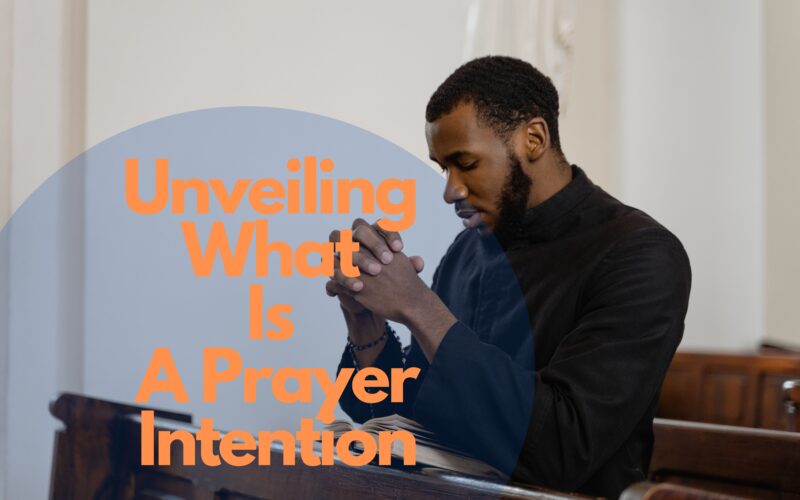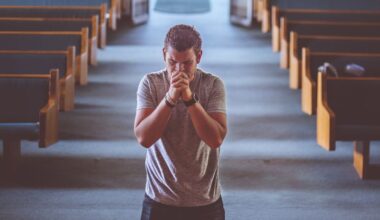Table of Contents Show
Prayer is a practice that has been embraced by various cultures and religions throughout history. It is a way to connect with a higher power, seek guidance, and find solace. Within the realm of prayer, there exists a concept known as a “prayer intention.” In this article, we will look into the concept what is a prayer intention and explore its significance in our lives.
What Is A Prayer Intention
A prayer intention is a specific purpose or goal that we set when we pray. It’s the heartfelt desire or request we bring to our prayers. While traditional prayers may include general blessings, thanksgiving, or expressions of faith, a prayer intention is more focused. It could be a personal request for healing, guidance, strength, or any specific need.
The Power of Prayer Intention
Prayer intentions hold a unique power. When we set a clear intention during prayer, we are essentially focusing our energy and thoughts on that particular goal. This intention becomes a driving force, leading us to work diligently towards our desired outcome.
How to Set a Prayer Intention
Setting a prayer intention is a deeply personal process. Start by finding a quiet and peaceful space. Reflect on what you truly desire or need. It could be for yourself or for someone else. Write it down or simply hold it in your heart. As you pray, let this intention guide your words and thoughts.
- Find a Quiet and Peaceful Space: To begin, choose a serene and quiet environment where you can concentrate without distractions. This could be a corner in your home, a peaceful garden, or even a tranquil spot in nature. The idea is to create a space where you can connect with your inner self and the divine.
- Reflect on Your Desires or Needs: Take some time to reflect on what you truly desire or need in your life. This can be a deeply personal process, and there are no limitations to what you can set as an intention. It could be for personal healing, guidance, strength, or for the well-being of a loved one. The key is to be sincere and genuine about your intention.
- Write it Down: While it’s not mandatory, writing down your prayer intention can be a powerful practice. It solidifies your commitment and serves as a tangible reminder of what you’re focusing on. You can use a journal, a piece of paper, or a digital note, depending on your preference.
- Hold it in Your Heart: If you prefer not to write it down, you can simply hold your intention in your heart. As you pray, visualize your intention clearly and let it resonate within you. Imagine it as if it’s already manifesting in your life. This heartfelt connection can be just as potent as writing it down.
- Pray with Intention: When you’re ready, begin your prayer. You can use your own words, or you may choose to recite traditional prayers that resonate with your intention. The crucial aspect is to infuse your prayers with your intention. Let it guide your words, thoughts, and emotions during this sacred moment.
- Maintain Faith and Positivity: Maintain faith in the power of your intention. Believe that your prayers are being heard and that positive changes are on the way. The strength of your belief can significantly influence the effectiveness of your prayer intention.
- Revisit Regularly: Setting a prayer intention isn’t a one-time event. It’s an ongoing practice. Revisit your intention regularly, either through daily prayers or periodic reflections. Keep your intention fresh in your mind, and remain open to the possibilities it may bring into your life.
The Role of Faith
Faith plays a significant role in prayer intentions. Believing that your intention will be heard and positively influence your life is crucial. The stronger your faith, the more potent the intention.
Different Types of Prayer Intentions
Prayer intentions come in various forms. They can be petitions for healing, guidance, forgiveness, or even gratitude. Each intention is as unique as the individual making the prayer.
- Healing Intentions: Many individuals turn to prayer to seek physical, emotional, or spiritual healing. These intentions are focused on restoring health, well-being, and inner peace. Whether it’s for oneself or a loved one, healing intentions are often rooted in the hope for recovery and relief from suffering.
- Guidance Intentions: Prayer can be a source of guidance and direction in times of uncertainty. Guidance intentions seek clarity, wisdom, and insight to make important decisions or navigate life’s complexities. People often ask for guidance when facing significant life choices or seeking a path forward.
- Forgiveness Intentions: Seeking forgiveness, whether from a divine source or from others, is a common form of prayer intention. These intentions express remorse, a desire for reconciliation, and the hope for a fresh start. They play a vital role in the process of personal growth and reconciliation.
- Gratitude Intentions: Gratitude is a powerful and positive emotion. Gratitude intentions involve expressing thankfulness for the blessings, opportunities, or relationships in one’s life. These prayers focus on acknowledging the goodness and abundance that exists, promoting a sense of contentment and positivity.
- Intercessory Intentions: Intercessory prayers are made on behalf of others. These intentions are selfless acts of kindness where individuals pray for the well-being, protection, or blessings of family, friends, or even strangers. Intercessory intentions reflect a sense of empathy and compassion for the welfare of others.
- Strength and Courage Intentions: In times of adversity, people often turn to prayer for strength, courage, and resilience. These intentions help individuals overcome challenges, face fears, and find the inner fortitude needed to persevere through difficult situations.
- Abundance Intentions: Abundance intentions focus on attracting prosperity, success, and abundance in various aspects of life, including career, finances, and relationships. These prayers aim to manifest a life filled with richness and fulfillment.
- Protection Intentions: Prayer for protection is common in many spiritual traditions. These intentions seek divine guidance and safeguarding from harm, negativity, and adverse circumstances. They provide a sense of security and peace of mind.
The Connection Between Prayer and Well-Being
Studies have shown that individuals who incorporate prayer and prayer intentions into their lives often experience a greater sense of well-being. It can reduce stress, anxiety, and promote emotional and mental balance.
Tips for Effective Prayer Intentions
To make your prayer intentions more effective, it’s essential to be specific, sincere, and persistent. Revisit your intention regularly, and don’t be disheartened if results aren’t immediate.
The Importance of Gratitude
Expressing gratitude is a fundamental aspect of prayer intentions. Being thankful for what you have while seeking what you need fosters a positive outlook on life.
Common Misconceptions
There are common misconceptions about prayer intentions, such as the belief that they are reserved for the highly religious. In reality, anyone, regardless of their faith or background, can set a prayer intention.
- Exclusivity to the Highly Religious: One prevalent misconception is that prayer intentions are reserved for devoutly religious individuals. In reality, prayer intentions are not exclusive to any specific faith or religious group. Anyone, regardless of their religious or spiritual background, can set a prayer intention. It’s a deeply personal practice open to all who seek a connection with the divine or a source of inner strength.
- Formal and Elaborate Rituals Required: Some believe that setting a prayer intention demands formal and elaborate rituals. While prayer can take various forms, from traditional ceremonies to informal moments of reflection, it doesn’t have to be complicated. Setting a prayer intention is often as simple as sincere thoughts or words from the heart.
- Immediate and Guaranteed Results: Another common misconception is the expectation of immediate and guaranteed results. While prayer intentions can be powerful, they don’t always lead to instant solutions. The process may involve patience and faith, and results can manifest in unexpected ways.
- Restriction to Specific Topics: People may think that prayer intentions must be limited to certain topics, such as healing or guidance. In reality, the range of prayer intentions is vast and diverse. You can set an intention for virtually anything, whether it’s personal growth, relationships, or the well-being of the world.
- Complex Language Required: Some individuals believe that prayer intentions must be expressed in complex, formal language. However, the essence of a prayer intention is sincerity and authenticity. You can convey your intentions in your own words, using a language that feels most comfortable to you.
- Ineffectiveness for Non-Believers: There’s a misconception that prayer intentions are only effective for those with strong religious beliefs. While faith can enhance the power of prayer, non-believers or individuals with diverse spiritual beliefs can still experience the benefits of setting intentions. It’s more about connecting with your inner self and the universe than adhering to a particular dogma.
- Isolation from Other Practices: Some people may think that setting prayer intentions should be done in isolation from other practices or rituals. However, prayer intentions can complement other spiritual or self-improvement practices. They can be integrated into daily life as a source of guidance and inspiration.
- Complexity of Setting Intentions: The process of setting a prayer intention is often seen as complex or challenging. In reality, it’s a straightforward and personal process. You can set an intention by reflecting on your needs, desires, or those of others, and expressing them sincerely.
Personal Testimonials
Many individuals have experienced the power of prayer intentions firsthand. Personal stories of healing, guidance, and transformation serve as powerful testimonials to the effectiveness of this practice.
Conclusion
In conclusion, a prayer intention is a focused and heartfelt request that can bring about positive changes in our lives. It is a powerful tool for personal growth and well-being, accessible to all. By setting clear intentions and maintaining faith, we can harness the extraordinary potential of this practice.
FAQs
FAQ 1: What is the difference between a prayer and a prayer intention?
While a traditional prayer may involve general expressions of faith, gratitude, or praise, a prayer intention is a specific request or goal that is the central focus of your prayer.
FAQ 2: Can I have more than one prayer intention at a time?
Yes, you can have multiple prayer intentions, but it’s essential to remain focused and sincere with each one.
FAQ 3: How long should I focus on a prayer intention?
The duration varies, but consistency is more important than the length. Keep your intention in mind as you pray, and revisit it regularly.
FAQ 4: Do I need to be religious to set a prayer intention?
No, prayer intentions are not limited to religious individuals. Anyone can set a prayer intention, regardless of their beliefs.
FAQ 5: Are there any scientific studies on the effectiveness of prayer intentions?
Yes, there have been studies exploring the impact of prayer intentions on health and well-being. While results may vary, many individuals report positive experiences with this practice.








